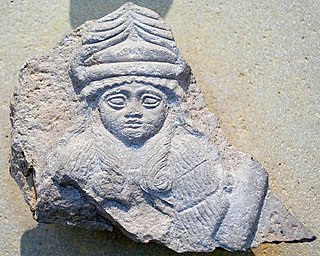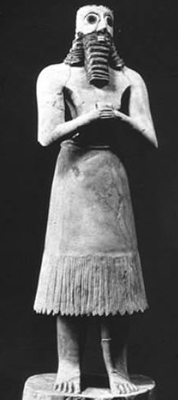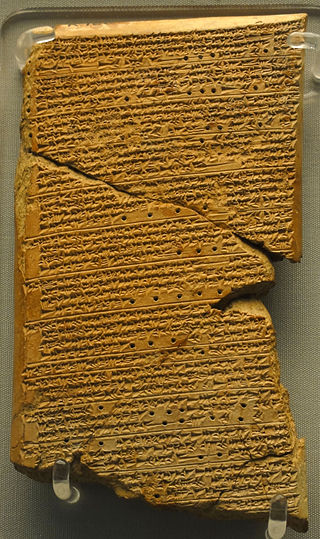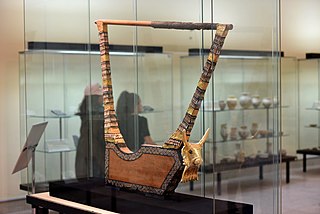Related Research Articles
Nintinugga was a Mesopotamian goddess associated with medicine and cleansing. She belonged to the local pantheon of Nippur. While she has been compared to other similar goddesses, such as Ninisina and Gula, and in a number of ancient texts they appear to be syncretised with each other or are treated as interchangeable, she was nonetheless a distinct deity in her own right. She was associated with Enlil and Ninlil, and was worshiped in their temples, though houses of worship dedicated only to her are also attested.

Bau (cuneiform: 𒀭𒁀𒌑 dBa-U2; also romanized as Baba or Babu) was a Mesopotamian goddess. The reading of her name is a subject of debate among researchers, though Bau is considered the conventional spelling today. While initially regarded simply as a life-giving deity, in some cases associated with the creation of mankind, over the course of the third and second millennia BCE she also acquired the role of a healing goddess. She could be described as a divine midwife. In art she could be depicted in the company of waterfowl or scorpions.

Ninsun was a Mesopotamian goddess. She is best known as the mother of the hero Gilgamesh and wife of deified legendary king Lugalbanda, and appears in this role in most versions of the Epic of Gilgamesh. She was associated with Uruk, where she lives in this composition, but she was also worshiped in other cities of ancient Mesopotamia, such as Nippur and Ur, and her main cult center was the settlement KI.KALki.
Damu was a Mesopotamian god. While originally regarded as a dying god connected to vegetation, similar to Dumuzi or Ningishzida, with time he acquired the traits of a god of healing. He was regarded as the son of the medicine goddess Ninisina, or of her equivalents such as Gula or Ninkarrak. It is unclear which city was originally associated with him, but he is best attested in association with the cult center of his mother, Isin.
Pabilsaĝ was a Mesopotamian god. Not much is known about his role in Mesopotamian religion, though it is known that he could be regarded as a bow-armed warrior deity, as a divine cadastral officer or a judge. He might have also been linked to healing, though this remains disputed. In his astral aspect, first attested in the Old Babylonian period, he was a divine representation of the constellation Sagittarius.
Ninazu was a Mesopotamian god of the underworld. He was also associated with snakes and vegetation, and with time acquired the character of a warrior god. He was frequently associated with Ereshkigal, either as a son, husband, or simply a member the same category of underworld deities.

Abu was a Mesopotamian god. His character is poorly understood, though it is assumed he might have been associated with vegetation and with snakes. He was often paired with the deity gu2-la2, initially regarded as distinct from Gula, but later conflated with her.
Ningirida was a Mesopotamian goddess regarded as the wife of Ninazu and mother of Ningishzida. Little is known about her character beyond her relation to these two gods.
Ama-arḫuš was a Mesopotamian goddess associated with compassion and healing or epithet of goddesses designating them as compassionate.

Nungal, also known as Manungal and possibly Bēlet-balāṭi, was the Mesopotamian goddess of prisons, sometimes also associated with the underworld. She was worshiped especially in the Ur III period in cities such as Nippur, Lagash and Ur.
Ninimma was a Mesopotamian goddess best known as a courtier of Enlil. She is well attested as a deity associated with scribal arts, and is variously described as a divine scholar, scribe or librarian by modern Assyriologists. She could also serve as an assistant of the birth goddess Ninmah, and a hymn describes her partaking in cutting of umbilical cords and determination of fates. It has also been suggested that she was associated with vegetation. In the Middle Babylonian period she additionally came to be viewed as a healing deity.

Geshtinanna was a Mesopotamian goddess best known due to her role in myths about the death of Dumuzi, her brother. It is not certain what functions she fulfilled in the Mesopotamian pantheon, though her association with the scribal arts and dream interpretation is well attested. She could serve as a scribe in the underworld, where according to the myth Inanna's Descent she had to reside for a half of each year in place of her brother.

Ninkarrak was a goddess of medicine worshiped chiefly in northern Mesopotamia and Syria. It has been proposed that her name originates in either Akkadian or an unidentified substrate language possibly spoken in parts of modern Syria, rather than in Sumerian. It is presumed that inconsistent orthography reflects ancient scholarly attempts at making it more closely resemble Sumerian theonyms. The best attested temples dedicated to her existed in Sippar and in Terqa. Finds from excavations undertaken at the site of the latter were used as evidence in more precisely dating the history of the region. Further attestations are available from northern Mesopotamia, including the kingdom of Apum, Assyria, and the Diyala area, from various southern Mesopotamian cities such as Larsa, Nippur, and possibly Uruk, as well as from Ugarit and Emar. It is possible that references to "Ninkar" from the texts from Ebla and Nikarawa, attested in Luwian inscriptions from Carchemish, were about Ninkarrak.

Ninisina was a Mesopotamian goddess who served as the tutelary deity of the city of Isin. She was considered a healing deity. She was believed to be skilled in the medical arts, and could be described as a divine physician or midwife. As an extension of her medical role, she was also believed to be capable of expelling various demons. Her symbols included dogs, commonly associated with healing goddesses in Mesopotamia, as well as tools and garments associated with practitioners of medicine.

Ninsianna was a Mesopotamian deity considered to be the personification of Venus. This theonym also served as the name of the planet in astronomical texts until the end of the Old Babylonian period. There is evidence that Ninsianna's gender varied between locations, and both feminine and masculine forms of this deity were worshiped. Due to their shared connection to Venus, Ninsianna was associated with Inanna. Furthermore, the deity Kabta appears alongside Ninsianna in many texts, but the character of the relation between them remains unclear.

Gula was a Mesopotamian goddess of medicine, portrayed as a divine physician and midwife. Over the course of the second and first millennia BCE, she became one of the main deities of the Mesopotamian pantheon, and eventually started to be viewed as the second highest ranked goddess after Ishtar. She was associated with dogs, and could be depicted alongside these animals, for example on kudurru, and receive figurines representing them as votive offerings.

Ningizibara, also known as Igizibara and Ningizippara, was a Mesopotamian goddess associated with the balaĝ instrument, usually assumed to be a type of lyre. She could be regarded both as a physical instrument and as a minor deity. In both cases, she was associated with the goddess Inanna. A connection between her and the medicine goddess Gula is also attested, and it is possible she could serve as a minor healing deity herself.
Meme or Memešaga was a Mesopotamian goddess possibly regarded as a divine caretaker. While originally fully separate, she eventually came to be treated as one and the same as Gula, and as such came to be associated with medicine. The god list An = Anum additionally indicates she served as the sukkal of Ningal.
Bulluṭsa-rabi was a Babylonian author and āšipu who most likely lived in the Kassite period. While sources from the first millennium BCE indicate at the time it was assumed that Bulluṭsa-rabi was a man, and this assumption was also initially followed by Assyriologists, further research showed that all individuals bearing this name recorded in earlier sources were women. A composition known from Nineveh, the Catalogue of Texts and Authors, attributes the authorship of a well known hymn to Gula and a number of unidentified texts to her.
Ninḫinuna or Ninḫenunna was a Mesopotamian goddess. She could be regarded as a servant deity or a deified instrument, specifically a harp or a lyre. She was associated with Inanna and Ninisina, as indicated by god lists and literary texts. She was worshiped in Old Babylonian Isin, as well as in Seleucid Uruk. However, in the latter city her introduction into the local pantheon might have been a late phenomenon reflecting the study of god lists, and she is absent from sources from the Neo-Babylonian period from the same location.
References
- 1 2 3 4 5 6 7 8 9 10 Edzard 1971, p. 701.
- 1 2 Wagensonner 2008, p. 279.
- ↑ Sibbing-Plantholt 2022, pp. 147–148.
- 1 2 3 Asher-Greve & Westenholz 2013, p. 84.
- 1 2 3 4 Sibbing-Plantholt 2022, p. 47.
- ↑ Sibbing-Plantholt 2022, p. 150.
- ↑ Koch 1995, p. 205.
- ↑ Westenholz 2010, p. 383.
- ↑ Wagensonner 2008, p. 284.
- ↑ Edzard 1971, pp. 701–702.
- ↑ Sibbing-Plantholt 2022, p. 9.
- ↑ Sibbing-Plantholt 2022, pp. 46–47.
- ↑ Schwemer 2001, p. 171.
- ↑ George 1993, p. 36.
- ↑ George 1993, pp. 5–6.
- ↑ Sibbing-Plantholt 2022, p. 124.
- ↑ Katz 2003, p. 5.
- ↑ Sibbing-Plantholt 2022, p. 126.
- ↑ Sibbing-Plantholt 2022, p. 147.
- ↑ Sibbing-Plantholt 2022, p. 31.
- ↑ Sibbing-Plantholt 2022, p. 46.
- ↑ George 1993, p. 67.
- ↑ George 1992, p. 304.
- ↑ George 1992, p. 332.
- ↑ Katz 2003, p. 309.
- ↑ Katz 2003, pp. 155–156.
- ↑ Katz 2003, p. 310.
- ↑ Delnero 2020, p. 478.
Bibliography
- Asher-Greve, Julia M.; Westenholz, Joan G. (2013). Goddesses in Context: On Divine Powers, Roles, Relationships and Gender in Mesopotamian Textual and Visual Sources (PDF). ISBN 978-3-7278-1738-0.
- Delnero, Paul (2020). How To Do Things With Tears. De Gruyter. doi:10.1515/9781501512650. ISBN 978-1-5015-1265-0.
- Edzard, Dietz Otto (1971), "Gunura", Reallexikon der Assyriologie, retrieved 2022-09-12
- George, Andrew R. (1992). Babylonian Topographical Texts. Orientalia Lovaniensia analecta. Departement Oriëntalistiek. ISBN 978-90-6831-410-6 . Retrieved 2022-09-12.
- George, Andrew R. (1993). House most high: the temples of ancient Mesopotamia. Winona Lake: Eisenbrauns. ISBN 0-931464-80-3. OCLC 27813103.
- Katz, Dina (2003). The Image of the Netherworld in the Sumerian Sources. Bethesda, MD: CDL Press. ISBN 1-883053-77-3. OCLC 51770219.
- Koch, Ulla Susanne (1995). Mesopotamian Astrology: An Introduction to Babylonian & Assyrian Celestial Divination. Museum Tusculanum Press. ISBN 87-7289-287-0.
- Schwemer, Daniel (2001). Die Wettergottgestalten Mesopotamiens und Nordsyriens im Zeitalter der Keilschriftkulturen: Materialien und Studien nach den schriftlichen Quellen (in German). Wiesbaden: Harrassowitz. ISBN 978-3-447-04456-1. OCLC 48145544.
- Sibbing-Plantholt, Irene (2022). The Image of Mesopotamian Divine Healers. Healing Goddesses and the Legitimization of Professional Asûs in the Mesopotamian Medical Marketplace. Boston: Brill. ISBN 978-90-04-51241-2. OCLC 1312171937.
- Wagensonner, Klaus (2008). "Nin-Isina(k)s Journey to Nippur. A bilingual divine journey revisited". Wiener Zeitschrift für die Kunde des Morgenlandes. 98. Department of Oriental Studies, University of Vienna: 277–294. ISSN 0084-0076. JSTOR 23861637 . Retrieved 2022-09-12.
- Westenholz, Joan G. (2010). "Ninkarrak – an Akkadian goddess in Sumerian guise". Von Göttern und Menschen. Brill. doi:10.1163/9789004187474_020.